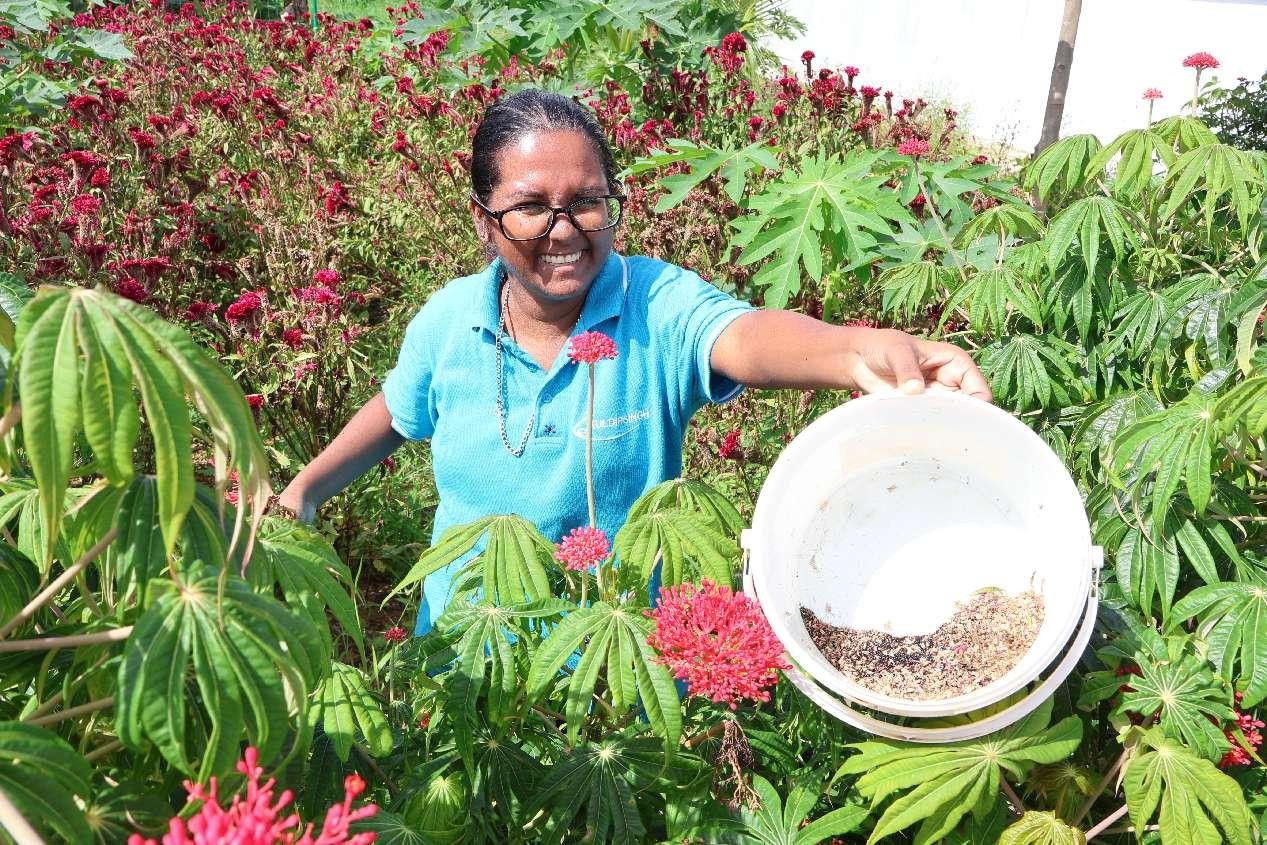当前位置 : International Daily News
 发布日期:2025/6/7
发布日期:2025/6/7
 来源:International daily
来源:International daily
 打印
打印
By Xie Jianing
People's Daily app
19:12, May 27, 2025
The China-aided Suriname Agricultural Technical Cooperation Center is located about a 90-minute drive from Paramaribo, capital of Suriname.
Liu Dejun, head of the center's Phase I project team and an expert in vegetable cultivation, was leading a group of Chinese agricultural specialists and local farmers as they conducted an inspection of crops in a nearby experimental field.
Watching the carefully cultivated vegetables and fruits beginning to blossom and bear fruit, Liu smiled with satisfaction.
More than two years ago, when Chinese agricultural experts arrived in Suriname, they encountered vast tracts of underutilized land. Local farmers, relying largely on traditional methods, sowed crops based on experience, often assuming that nature would take care of the rest. The absence of modern farming techniques and science-based cultivation practices had led to inconsistent yields.
Since the launch of the China-aided Suriname Agricultural Technical Cooperation Center in 2022, the Chinese team has established various specialized programs in vegetable and fruit cultivation, edible mushrooms, and the use of agricultural machinery.
Tailoring their methods to Suriname's unique climate and soil conditions, Chinese experts have conducted trials and demonstrations, promoted new crop varieties, and introduced innovative techniques such as intercropping corn and soybeans. They have also trained a number of lead farmers with basic planting experience, providing them with technical guidance and agricultural inputs.
Sharina, a local farmer who grew up cultivating peanuts, sweet potatoes, and bananas, recalled her first encounter with the center. "When I heard the Chinese agricultural experts had arrived, I visited with a friend. The first time I saw the crops they were growing, I was amazed. Chili peppers grown by the Chinese experts were thriving, while ours were sparse and stunted. That's when I decided to start learning from them," she said.

Salina poses for a picture with seeds she collected from an experimental field at the China-aided Suriname Agricultural Technical Cooperation Center. (Photo: Ernesto Domínguez)
Liu explained the comprehensive training process. "We trained farmers in a wide range of skills, such as pest and disease identification and eco-friendly control, science-based fertilization, precision seeding and seedling cultivation, water-saving irrigation, high-yield practices, and crop selection. By combining classroom instruction with hands-on fieldwork, we've been able to improve farmers' technical skills and agricultural productivity."
The cooperative efforts have extended beyond traditional training sessions. Trainees and experts have formed social media groups, allowing farmers to ask questions and receive immediate assistance. "I've shared what I learned with my family and even experimented with vegetable varieties I'd never grown before," said Sharina. "The joy of harvesting is something words can't capture. Seeing the land reward your hard work is incredibly fulfilling."
The ripple effect of this knowledge exchange has spread throughout Suriname. Linda, an official at the Para District office of the Ministry of Agriculture, Livestock and Fisheries of Suriname remarked, "When you step into the fields, the difference is clear. The Chinese-led training has introduced us to agricultural techniques and ideas we'd never encountered before. For instance, we once thought bigger fruit trees were better, but now we understand that proper pruning and seedling management lead to higher yields and better quality."
The expertise brought by Chinese experts now supports vegetable and fruit farms covering more than 100 hectares. They have conducted over 200 on-site technical visits and trained nearly 350 people. Many of these trainees come from distant areas of Suriname, traveling up to three hours by bus each day to receive training from Chinese experts.
"Our goal is to help Suriname achieve true agricultural self-sufficiency and sustainable development," said Liu Jingguo, a Chinese expert in fruit cultivation. "We hope that when we leave, the farmers here will be able to apply what they've learned with confidence and continue to grow their land successfully."
"Three years ago, this area was just barren land. Now it's thriving with greenery," said Wang Chuanrui, a member of the National Assembly of Suriname. "Chinese experts have not only brought advanced techniques such as fertigation and nutrient diagnosis but also gradually changed the way people here think about farming. More and more farmers are adopting science-based cultivation methods, and both the output and quality of local agriculture have improved significantly."
Jia Jinyi, economic and commercial counselor of the Chinese Embassy in Suriname, noted that the center is the first agricultural assistance project since the establishment of diplomatic ties between the two countries.
The project has yielded remarkable results in technology transfer, crop introduction, infrastructure development, and talent training, Jia added.
According to him, 32 crop varieties have been promoted so far, benefiting more than 6,500 local farmers. This project has laid a solid foundation for enhancing Suriname's agricultural independence and promoting sustainable development.
Jason Bakker, an official with Suriname's Ministry of Agriculture, Livestock and Fisheries, praised the project as a prime example of how agricultural cooperation between Latin America and China is entering a new stage.
He observed that this collaboration has transformed Suriname's traditional, extensive farming practices and significantly increased yields of crops such as citrus and bananas. Some farmers have reported income gains of more than 60 percent, demonstrating the strong adaptability and effectiveness of Chinese agricultural technologies in emerging markets.
Bakker further noted that the modernization needs of Latin American agriculture align closely with China's technological, financial, and market strengths. He pointed out that agricultural cooperation between Latin America and China is becoming a new model for South-South cooperation, with a focus on practical outcomes and aimed at building a community with a shared future.









